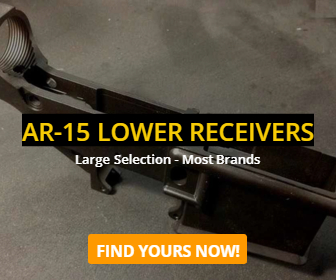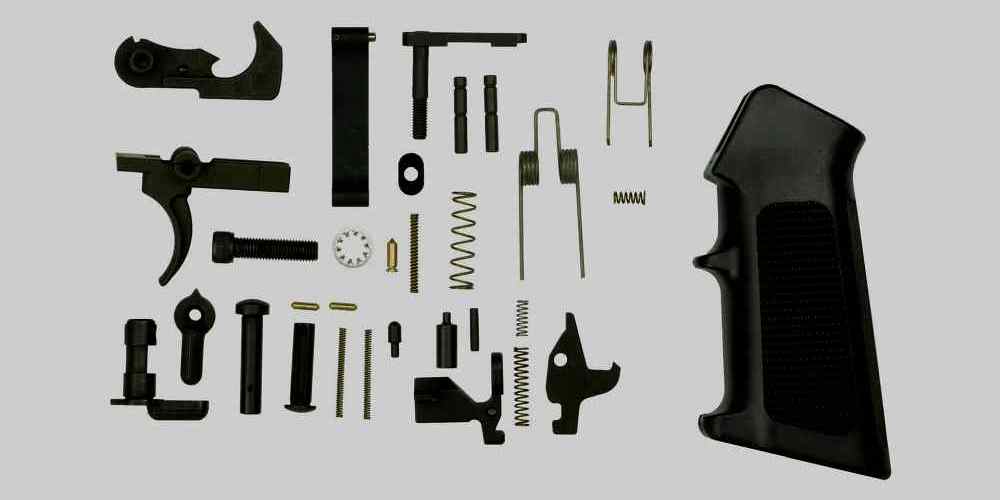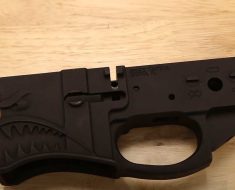“Precision and Performance: Choosing the Perfect Lower Receiver for Competitive Shooting”
Material
When it comes to competitive shooting, every detail matters. From the type of ammunition you use to the accessories on your firearm, each component plays a crucial role in your performance. One of the most important parts of a competitive shooter’s firearm is the lower receiver. This component serves as the foundation of the firearm, connecting the stock, grip, and trigger assembly. When choosing a lower receiver for competitive shooting, there are several key factors to consider, with material being one of the most important.
The material of the lower receiver can have a significant impact on the performance and durability of your firearm. The two most common materials used for lower receivers are aluminum and polymer. Aluminum is a popular choice among competitive shooters due to its strength and durability. It is also lightweight, which can help reduce fatigue during long shooting sessions. Aluminum lower receivers are typically machined from a solid block of aluminum, making them incredibly sturdy and reliable.
On the other hand, polymer lower receivers are gaining popularity among competitive shooters due to their lightweight and cost-effective nature. Polymer lower receivers are made from a high-strength polymer material that is resistant to corrosion and impact. While polymer lower receivers may not be as durable as their aluminum counterparts, they are still a viable option for competitive shooters looking to save weight and money.
When choosing a lower receiver material for competitive shooting, it is important to consider your shooting style and preferences. If you prioritize durability and reliability, an aluminum lower receiver may be the best choice for you. However, if weight and cost are more important factors, a polymer lower receiver may be a better option.
It is also worth noting that some competitive shooting disciplines have specific rules and regulations regarding the type of material that can be used for lower receivers. Before making a purchase, be sure to familiarize yourself with the rules of your chosen discipline to ensure that your firearm is compliant.
In addition to material, it is important to consider the quality of the lower receiver. Look for a reputable manufacturer with a track record of producing high-quality firearms components. A well-made lower receiver will have tight tolerances and smooth edges, ensuring a snug fit with other components of your firearm.
Ultimately, the material of the lower receiver is just one of many factors to consider when choosing a lower receiver for competitive shooting. Take the time to research and compare different options to find the best fit for your needs. Whether you choose an aluminum or polymer lower receiver, prioritize quality and reliability to ensure optimal performance on the range.
Weight
When it comes to competitive shooting, every detail matters. From the type of ammunition you use to the accessories on your firearm, each component plays a crucial role in your performance. One often overlooked aspect of a competitive shooter’s setup is the lower receiver of their firearm. The lower receiver is the part of the gun that houses the trigger group and magazine well, and it plays a significant role in the overall weight and balance of the firearm.

Weight is a critical factor to consider when choosing a lower receiver for competitive shooting. The weight of the lower receiver can affect the balance of the firearm, which in turn can impact your accuracy and control. A heavier lower receiver can help reduce recoil and muzzle rise, making it easier to stay on target during rapid fire. On the other hand, a lighter lower receiver can make the firearm easier to maneuver and carry for extended periods of time.
When looking for a lower receiver for competitive shooting, it’s essential to find a balance between weight and performance. A lower receiver that is too heavy can be cumbersome and tiring to shoot, while a lower receiver that is too light may not provide enough stability for precise shooting. It’s important to consider your shooting style and preferences when choosing a lower receiver, as what works for one shooter may not work for another.
One option to consider when looking for a lower receiver for competitive shooting is a billet lower receiver. Billet lower receivers are machined from a solid block of aluminum, making them stronger and more durable than forged lower receivers. They also tend to be heavier than forged lower receivers, which can help reduce recoil and improve stability. However, billet lower receivers can be more expensive than forged lower receivers, so it’s important to weigh the cost against the benefits.
Another option to consider is a forged lower receiver. Forged lower receivers are made by hammering a piece of aluminum into shape, which can result in a lighter and more affordable lower receiver. While forged lower receivers may not be as strong as billet lower receivers, they are still durable enough for most competitive shooting applications. It’s essential to consider the trade-offs between weight, strength, and cost when choosing between billet and forged lower receivers.
Ultimately, the best lower receiver for competitive shooting is one that fits your shooting style and preferences. Whether you prefer a heavier lower receiver for stability or a lighter lower receiver for maneuverability, there are options available to suit your needs. It’s essential to do your research and consider all factors before making a decision, as the right lower receiver can make a significant difference in your performance on the range.
In conclusion, weight is a crucial factor to consider when choosing a lower receiver for competitive shooting. Finding the right balance between weight and performance can help improve your accuracy, control, and overall shooting experience. Whether you opt for a billet or forged lower receiver, it’s essential to consider your shooting style and preferences to find the best option for you. With the right lower receiver, you can take your competitive shooting to the next level and achieve your full potential on the range.
Compatibility
When it comes to competitive shooting, every detail matters. From the type of ammunition you use to the accessories on your firearm, each component plays a crucial role in your performance. One of the most important parts of a competitive shooter’s firearm is the lower receiver. This component is the foundation of your rifle, connecting the stock, barrel, and upper receiver. When choosing a lower receiver for competitive shooting, compatibility is key.
The first thing to consider when selecting a lower receiver is the compatibility with your upper receiver. The lower and upper receivers must be compatible in order for your firearm to function properly. This means that the two components must fit together seamlessly and securely. It is important to ensure that the lower receiver you choose is designed to work with the specific upper receiver you plan to use. This will help prevent any issues with alignment or functionality down the line.
In addition to compatibility with the upper receiver, it is also important to consider the compatibility of the lower receiver with other components of your firearm. This includes the stock, grip, trigger, and magazine. Each of these components must work together smoothly in order to achieve optimal performance. When selecting a lower receiver, make sure to choose one that is compatible with the other parts of your firearm. This will help ensure that everything fits together properly and functions as intended.
Another factor to consider when looking for a lower receiver is the compatibility with aftermarket parts. Many competitive shooters like to customize their firearms with aftermarket accessories and upgrades. When choosing a lower receiver, it is important to select one that is compatible with a wide range of aftermarket parts. This will give you the flexibility to customize your firearm to suit your specific needs and preferences.
When it comes to compatibility, it is also important to consider the type of ammunition you plan to use. Different lower receivers are designed to work with specific types of ammunition. Make sure to choose a lower receiver that is compatible with the caliber and type of ammunition you plan to shoot. This will help ensure that your firearm functions reliably and accurately.
In conclusion, compatibility is a crucial factor to consider when selecting a lower receiver for competitive shooting. Make sure to choose a lower receiver that is compatible with your upper receiver, other components of your firearm, aftermarket parts, and the type of ammunition you plan to use. By taking the time to ensure compatibility, you can help ensure that your firearm functions reliably and performs at its best.
Durability
When it comes to competitive shooting, every detail matters. From the type of ammunition you use to the accessories on your firearm, each component plays a crucial role in your performance. One of the most important parts of a competitive shooter’s firearm is the lower receiver. This component is the foundation of your rifle, connecting the stock, barrel, and upper receiver. When choosing a lower receiver for competitive shooting, durability is key.
Durability is essential in a lower receiver because competitive shooters put their firearms through rigorous use. Whether you are participating in a long-range precision shooting competition or a fast-paced action shooting match, your lower receiver needs to be able to withstand the demands of the sport. A durable lower receiver will not only last longer but also provide you with consistent performance, shot after shot.
One of the first things to consider when looking for a durable lower receiver is the material it is made from. Lower receivers are typically made from either aluminum or polymer. Aluminum lower receivers are known for their strength and durability, making them a popular choice among competitive shooters. They are resistant to wear and tear, corrosion, and impact, ensuring that your firearm will perform reliably in any shooting conditions.
Polymer lower receivers, on the other hand, are lightweight and affordable but may not be as durable as aluminum. While polymer lower receivers can be a good option for casual shooters or those on a budget, they may not hold up as well under the intense use of competitive shooting. If durability is a top priority for you, it is recommended to choose an aluminum lower receiver for your competitive shooting needs.
In addition to the material, the design of the lower receiver also plays a significant role in its durability. Look for lower receivers that have been precision-machined to ensure a tight fit with other components of your firearm. A well-fitted lower receiver will reduce the risk of malfunctions and improve the overall performance of your rifle.
Another factor to consider when evaluating the durability of a lower receiver is the finish. A high-quality finish will not only protect the lower receiver from scratches and corrosion but also enhance its overall appearance. Anodized finishes are popular among competitive shooters for their durability and resistance to wear. They come in a variety of colors, allowing you to customize your firearm to your liking.
When it comes to competitive shooting, durability is a crucial factor to consider when choosing a lower receiver for your firearm. By selecting a lower receiver made from high-quality materials, precision-machined for a tight fit, and finished with a durable coating, you can ensure that your firearm will perform reliably and consistently in any shooting conditions. Remember, every detail matters in competitive shooting, so choose your lower receiver wisely.
Price
When it comes to competitive shooting, every detail matters. From the type of ammunition you use to the accessories on your firearm, each component plays a crucial role in your performance. One of the most important parts of a competitive shooter’s firearm is the lower receiver. This component serves as the foundation of the firearm, connecting the stock, barrel, and upper receiver. When choosing a lower receiver for competitive shooting, there are several factors to consider, with price being a key consideration.
Price is often a determining factor when selecting a lower receiver for competitive shooting. While it’s tempting to opt for the most affordable option, it’s important to remember that quality should not be sacrificed for cost. A lower receiver that is too cheap may be made of inferior materials or lack the precision machining necessary for optimal performance. On the other hand, a higher-priced lower receiver may offer advanced features and superior craftsmanship that can enhance your shooting experience.
When considering price, it’s essential to strike a balance between affordability and quality. Look for lower receivers that are competitively priced within your budget range while still meeting your performance needs. Keep in mind that a higher price tag does not always equate to better performance. Some lower receivers may be overpriced due to branding or unnecessary features that do not significantly impact shooting performance.
To ensure you are getting the best value for your money, research different brands and models of lower receivers. Look for reviews from other competitive shooters to see how a particular lower receiver performs in real-world scenarios. Pay attention to the materials used in construction, such as aluminum or polymer, as well as the manufacturing processes employed. A well-made lower receiver will have tight tolerances and smooth operation, contributing to improved accuracy and reliability on the range.
In addition to price, consider the warranty and customer support offered by the manufacturer. A reputable company will stand behind their products with a solid warranty that covers defects in materials and workmanship. Good customer support is also essential, as it can make a significant difference if you encounter any issues with your lower receiver. Look for companies that are responsive to customer inquiries and provide timely assistance when needed.
Ultimately, the price of a lower receiver should be viewed as an investment in your competitive shooting performance. While it’s important to stay within your budget, don’t be afraid to spend a little more for a higher-quality product that will enhance your shooting experience. Remember that a well-made lower receiver can last for years and provide consistent performance on the range.
In conclusion, when choosing a lower receiver for competitive shooting, price is a crucial factor to consider. Strike a balance between affordability and quality, and research different brands and models to find the best value for your money. Look for well-made lower receivers with solid warranties and excellent customer support to ensure a positive shooting experience. By investing in a quality lower receiver, you can enhance your competitive shooting performance and enjoy improved accuracy and reliability on the range.






